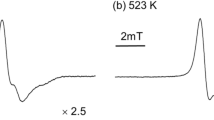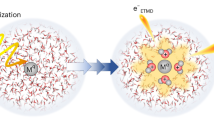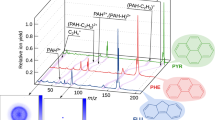Abstract
IT has been known for some time1,2 that the presence of aromatic compounds in solutions of saturated hydrocarbons can protect the solvent against radiation-induced decomposition. Since the aromatic solute plays a mainly ‘non-sacrificial’ part, scavenging of chemical intermediates (atoms, radicals, or ions) cannot be the major process in the observed protection3–5. Rather, it has been proposed2 that some sort of efficient energy transfer from the solvent, which absorbs the primary radiation, to the solute must operate. The recent observations of thermal electrons produced in relatively high yield in the radiolysis of aliphatic hydrocarbons in the glassy6 and liquid7 states indicated that it would be interesting to investigate whether there is a link between radiation protection by aromatic compounds and their electron affinity as it is known that these compounds are electron acceptors.
This is a preview of subscription content, access via your institution
Access options
Subscribe to this journal
Receive 51 print issues and online access
$199.00 per year
only $3.90 per issue
Buy this article
- Purchase on Springer Link
- Instant access to full article PDF
Prices may be subject to local taxes which are calculated during checkout
Similar content being viewed by others
References
Schoepfle, C. S., and Fellows, C. H., J. Indust. Eng. Chem., 23, 1396 (1931).
Manion, J. P., and Burton, M., J. Phys. Chem., 56, 560 (1952).
Burton, M., and Lipsky, S., J. Phys. Chem., 61, 1461 (1957).
Stone, J. A., and Dyne, P. J., Radiat. Res., 3, 353 (1962).
Sherman, W. V., Chem. and Indust., 28, 1266 (1964); J. Chem. Soc. (in the press).
Ronayne, R. R., Guarino, J. P., and Hamill, W. H., J. Amer. Chem. Soc., 84, 4230 (1962); Radiat. Res., 17, 379 (1962).
Scholes, G., and Simic, M., Nature, 202, 895 (1964). Scholes, G., Simic, M., Adams, G. E., Boag, J. W., and Michael, B. D., Nature, 204, 1187 (1964).
Lovelock, J. E., Nature, 189, 729 (1961). Lovelock, J. E., Zlatkis, A., and Becker, R. S., Nature, 193, 540 (1962). Lovelock, J. E., Simmonds, P. G., and Van den Heuvel, W. J. A., Nature, 197, 249 (1963).
Author information
Authors and Affiliations
Rights and permissions
About this article
Cite this article
SHERMAN, W. A Correlation between Electron Affinity and Protection in the Radiation Chemistry of Hydrocarbons. Nature 210, 1285–1286 (1966). https://doi.org/10.1038/2101285a0
Issue Date:
DOI: https://doi.org/10.1038/2101285a0
Comments
By submitting a comment you agree to abide by our Terms and Community Guidelines. If you find something abusive or that does not comply with our terms or guidelines please flag it as inappropriate.



